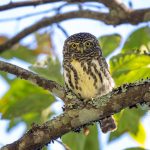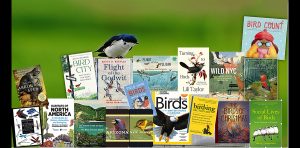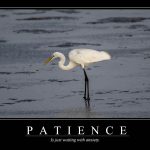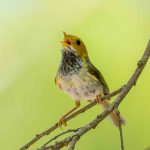The kids can’t get enough of this stuff.
“Who’s ever seen an x-ray?” I ask. “Anyone ever broken a bone?”
Hands shoot up.
“Here is an x-ray of a bird,” I say. “It’s a really big bird. Any guesses?”
 A ghostly image appears on the screen. The kids’ eyes widen. Hands raise and wave.
A ghostly image appears on the screen. The kids’ eyes widen. Hands raise and wave.
Once we’ve established that it’s a Golden Eagle, I ask the ten-million dollar question. “You see all those little round circles? What do you think they are?”
Only once has a child guessed correctly.
“It’s buckshot,” I say.
“Somebody shot an eagle?” asks a high-pitched voice, in disbelief.
Bunny-huggers, our critics snipe. Why do you wildlife rehabilitators waste your time saving a cardinal with a broken wing, when you could be giving your money to save habitat?
All rehabbers have a rescue jones, but everyone has their own reasons for spending ungodly amounts of time, effort, money, and emotion on an endeavor which, to an outsider, may look insane. Nestling bluebirds have to be fed every 20 minutes from sunup to sundown. Emaciated egrets need to be fed through the night. Once the nestlings grow up, once the starving birds are restored to health, they are released – and their futures are not guaranteed.
So what’s the point?
Part of it is the ripple effect. The outdoor cat owner who brings a rehabber a shredded songbird may learn not to let their cat out. The homeowner who cuts down a dead tree and seeks a rehabber’s help with the fallen nest of owlets may bring it up at his next Town Board meeting. The fisherman who rescues a merganser tangled in line, pierced with fishhooks, and brings it to a rehabber may write something in his next angler’s newsletter. But if there no one to care for these birds all the potential lessons will be lost, and it will become clear that a single life doesn’t matter.
A single life does matter. How many EMTs have to defend what they do? They don’t, because humans are so vastly superior to animals – even child molesters, serial killers, and terrorists. We put people in prison for life for the most heinous of crimes, then, if they have a heart attack, solicitously resuscitate them and put them back again.
Wildlife rehabilitators should not have to defend what they do. A bird who was hit by a car is brought to me; she is in pain and will die unless I help. I provide relief and aid and care until, with luck, she recovers. During this time I am able to spend time with one of the most magical creatures on the planet, even though I cannot cross the divide and intrude upon her wild nature. Sometimes she is a member of an endangered or threatened species. When the time comes to release her, I hold her, open my hands and watch her disappear into the sky. My heart sings.
On the other hand, I could simply write a check.
Don’t get me wrong. I love people who write checks. People who write checks have allowed me to do what I do. But they write me checks because, even though they think I am nuts, they love what I do, too.













Individual lives do indeed matter. That’s why there are physicians that spend their lives going from patient to patient struggling with all their might to rid people of cancer that has invaded their body. There are other equally skilled physicians that could be out there helping individuals that instead spend all of their time in labs struggling to find a cure for cancer. They never treat anyone directly.
Which doctor is doing more good for humanity? There is no correct answer, as it’s all a matter of perspective – a perspective that can change under given circumstances, and then change back again.
You devote your life and resources to aiding individual animals that for one or reason or another are hurting. I devote any available resources I have to protection of habitat and similar population-conservation efforts to the exclusion of individual rehab. Which one of us loves nature more? I would hope that neither of us would dare to even think about answering that question. Neither should anyone else.
What I do gives me hope for the future and fills me with a joy and satisfaction that’s difficult to articulate, but I’m certain I wouldn’t get the same feeling from doing rehab. Your heart sings when your rehabbed birds disappear into the sky, mine does when I know a patch of swamp ecosystem is functioning like it should with all the allied life that entails. Different perspective, different goals, same joy, same heart-aching love of nature – in my humble opinion.
I don’t know what kind of opponents you are up against, but I noticed something odd–back when we had that amazing NYCbirdreport.com, people were noting a waterthrush daily, until early winter. Eventually, people started reporting evidence of a broken wing. The reports kept coming–blah blah blah “continues.” I was thinking “what’s wrong with you people?” These were not tax collectors, they were birders, recording an injured bird until it dies. Maybe it was a matter of not having info on rehabilitators, maybe they were letting nature “take its course.” Anyway, the day I came with a rehab’s address, a paper bag and a lot of determination, the bird was gone.
I’ve thought about this before and I’ve come to believe for most people, and I include myself in this, having the opportunity to care about the lives of individual animals makes it easier to eventually take the leap to preserving ecosystems and making the hard adjustments needed to curtail our worst impacts on the environment. This is especially true for children, one chance encounter with a bird could start a kid on an entire career path or a lifelong passion. So even from a “thinking globally” perspective, showing care for that individual cardinal could be important.
I’m fairly ambivalent about wildlife rehab, I’ve helped at centres before but I’ve also railed against rehabbers on my blog. I think it comes down to a case of being mildly supportive of rehab when it involves otherwise healthy animals injured for some reason by humans, but generally against rescuing animals that for whatever reason have been selected against by evolution. One of the worst cases of rehab I ever encountered was rescuing sea lions in California that had been starving due to El Nino. These poor creatures were at death’s door, were rescued and fed up, then released back into the very same ocean that had been unable to support them before. They lay up on the island I worked on in their shiny orange rehab tags and starved to death a second time. A waste of money and cruel to boot.
Every single life matters but Duncan’s point is well made. Whether re-habbing or trying to save eco systems, it is ( generally ) a good thing. If the right person cared at the right time maybe Lonesome George wouldn’t have been quite so lonesome and yes i accept you need 60 or so for not so shallow gene pool but it was more to illustrate the point.
Thank you for doing what you do. I think it matters greatly, and I appreciate it. I saw a marsh hawk earlier this year with a reed embedded in its back and wondered who, if anyone, could possibly help it. It was still flying and hunting, but it had to be at a serious disadvantage and possibly in pain. How does a reed get into a bird’s back? I don’t know, but I still wonder about its status. I was very moved by your post and I especially love picturing the children learning about eagles and already loving them and not being able to understand how someone could shoot one.
Wonderful post! Wonderful responses as well – Kirby, your response is so eloquently stated. Having been a rehab supervisor during the rescue of 40,000 penguins from the Treasure oil spill in South Africa 12 years ago – and having had people question why I studied veterinary medicine instead of human medicine – this post resonated strongly with me. I briefly address this same issue in my book, The Great Penguin Rescue, and it is the main thesis upon which my TED talk about the rescue is based. (http://www.ted.com/talks/dyan_denapoli_the_great_penguin_rescue.html)
It seems as though each time there is an oil spill, there are vocal opponents to the animal rescue efforts. And while there are times when euthanasia is the most humane answer, injured or oiled animals that can be saved deserve a second chance at life – especially when humans have been the source of their suffering.
For many of us, it’s just in our DNA to want to save every ill or injured animal – and we’ll never be able to change some peoples’ minds about the value of rescue and rehab. Pay them no mind though. For all of you wildlife rehabbers out there, just keep on keepin’ on, and ignore the naysayers. (Like I have to tell you!) YOU know that you are doing the right thing for those hurting animals. For all of the animals’ lives that you’ve saved and for all of the pain that you’ve eased, I, for one, thank you.
I am a migratory bird rehabber in NC. It does seem futile sometimes to try and save wildlife. Lots time and patience to rehab even a few birds every year.Some of my friends do think I am a little nuts to even bother. But, it matters to me. We are Gods gaurdians of the planet and I feel it is my job somehow to not turn my back on Gods creatures,no matter how futile it seems.When I watched a barn owl pair the other night hunting and screeching at me, I was in awe.Nature is so amazing.There is so much to learn.
Suzie,
Thank God for you and your crazy kind! The love that you give with that big heart of yours is powerful and magical, just like those magical souls you save and send back up to sing in the sky.
God must smile ..
Thank you all for your comments, I really appreciate the feedback. I agree with you completely, Kirby, how crazy it is to try to create some kind of most-valuable hierarchy when it comes to environmentalism! I can rehab all the birds I want to, but what do I do then if there is no habitat in which to release them? One of my local environmental heroes has put easements across her land so her property can never be carved up by developers, the other spends many summer weekends doggedly pulling purple loosestrife out of swamps.
Not all rehabbers do the right thing, like with those poor sea lions … though I wish a good rehabber had found the waterthrush. Good for you for trying, though, David.
Dyan, your TED talk was absolutely incredible! My jaw dropped when I saw that semi ready to truck healthy penguins 500 miles away, and loved that teenaged stroke of genius, as well as the war wounds from the ones you’re trying to help. You are an inspiration to rehabbers everywhere. I’m posting your talk site my listservs & FB page. Thank YOU for all you’ve done.
Suzie, I’m not sure it is that crazy to create a “most-valuable hierarchy” of conservation or environmentalism. Conservation organisations have limited funds and many prioritise their allocation, usually by considering the effectiveness of an activity and the threat level of the species or system involved. If you have 100k to spend on protecting wildlife you won’t want to spend all of it on leaflets discussing the importance of not disturbing mallards when you could protect the habitat of a critically endangered species.
The distinction I think is that wildlife rehabilitation is a separate field of interest from wildlife conservation. Conservation and animal welfare have a certain amount of overlapping interest and many supporters of one will be supporters of the other, but they do have different goals. It is perhaps unfair to judge the effectiveness of wildlife rehabilitation by the standards of wildlife conservation, although the corollary to that would be that it would be misleading to overstate the effectiveness of it as a form of conservation.
Suzie, this piece resonated with me. I’ve grown tired not only of defending the rescue and rehab work I’ve done, but also for defending wildlife and animals in general. As you write, a rehabilitator’s impact extends far beyond the individual animal, even though I personally believe in the inherent value of that single life. I can’t easily walk away from suffering, human or non-human. That’s my personal issue. But, it’s also through random field rescue efforts that I’ve been able to educate countless people who would have otherwise walked by, oblivious to the wildlife and the tenuous existence of that wildlife in their midst. I often say to the critics that people ought to invest their time and energy into the causes that most fuel their passions, whether they are human-centered, ecological, animal-related or other. A large percentage of humans aren’t doing anything at all outside their self-interest. I believe all contributions to the wellness of this planet and toward the larger goal of compassion, however small those efforts, cannot be overstated and should not be diminished in how they benefit us all.
Duncan, I agree there should be a “most-valuable hierarchy” WITHIN conservation orgs – the more critical the situation, the more funds they should allocate to it.
I also agree you can’t argue the effectiveness of wildlife rehab as a form of conservation, unless you’re talking about endangered species – when every bird is critical and sometimes rehabbers do captive breeding. It would fall more under a form of education, public awareness, and hopefully reaching people and instilling that passion that Ingrid wrote so well about. I rehabbed birds for years – if you could somehow measure everything involved, would it have been better if I had been able to donate 300 acres to Audubon? Maybe. But then I wrote a book about rehabbing, and received emails from an awful lot of people saying they’d never even noticed birds before, and now they’d bought a pair of binoculars and were dragging their kids out on nature walks and donating to local wildlife organizations.
I’m writing for a PA-based website about fracking (Shalereporter.com), something I didn’t know much about when I started. Now I can’t believe NY is considering allowing this insane practice to go forward. It’s already poisoning water and land all over the country – what’s going to happen to our wildlife (and us?) How do people who have killed themselves working to create a beautiful, protected local ecosystem feel when Halliburton sets up a fracking site right next to it? Is it all for nothing? Sometimes I think the trick with environmentalism is to stick to your tunnel vision and not look at the big picture, or you’ll go crazy.
The narrow perspective and the big picture both have their values, but it is just as easy to become disheartened with tunnel vision if you’re not focused on the right thing. Still, your post has got me thinking, and I’m writing some thoughts about conservation and animal right/welfare for my story next week. Interestingly, my conclusion about big picture/narrow focus is somewhat different.
Looking forward to reading your post. Take a look at this from today’s NY Times, which mentions spending money on conserving habitat vs captive breeding:
http://www.nytimes.com/2012/07/05/science/matchmaking-at-zoos-is-rising-for-threatened-species.html?ref=todayspaper
I remember doing captive breeding versus habitat management back in my masters in conservation. As with rehabbing there are separate values for the conservation value of a zoo versus the other benefits zoos might bring.